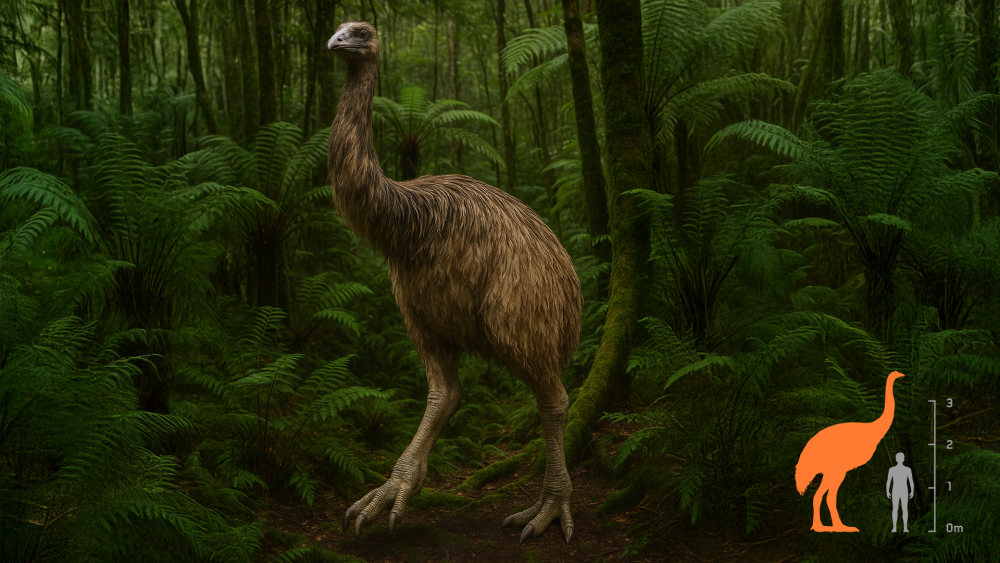Humans once lived among enormous, wingless birds in New Zealand, but within a few hundred years of our species arrival, they were wiped out. Now, Colossal Biosciences has announced its plans to functionally de-extinct the moa, building complete genomes for all nine species as part of a Māori-led initiative.
“When humans first arrived on Aotearoa New Zealand about 800 to 900 years ago, there were nine species of these dinosaur-sized giant birds,” said Colossal Advisor Dr Paul Scofield, Senior Curator of Natural History at Canterbury Museum, in the announcement video. “Within the first hundred and fifty years of human presence, all nine species became extinct.”
“Their existence was almost mythological.”
We have sampled over 60 bones and are already working on several moa species genomes
Ben Lamm, Colossal CEO
The nine species of moa ranged in size from something not far off a turkey to the South Island giant moa, Dinornis robustus, which towered at 3.6 meters (11.8 feet) tall and weighed approximately 230 kilograms (507 pounds). They were ecosystem engineers that shaped New Zealand’s grasslands and forests for millions of years, and the knock-on effects of their rapid extinction are still visible in the landscape today.
Hunting and habitat degradation were the drivers of their demise, but the mighty moa left behind some memorable remains. As well as fossils, they include a remarkable foot with soft tissues intact that really drives home how these birds were unlike anything we see alive today. In fact, “It’s one of the only birds ever known that has no wings at all,” said director Peter Jackson, who is a key collaborator on the project.
These remains will be pivotal if we’re going to piece together the moa genome. We already have a near-complete version for the little bush moa, Anomalopteryx didiformis, but we still have much more to learn.
“We have sampled over 60 bones and are already working on several moa species genomes,” Ben Lamm, CEO and co-founder of Colossal, told IFLScience. “Our goal is to not just work on the genome for the South Island giant moa, but to build genomes for all nine species of moa.”
This partnership is truly Māori-led. We look at them almost like our board of directors for this species project and look to them to set the pace, cadence, and direction that we go.
Ben Lamm, Colossal CEO
The project marks a historic indigenous-coordinated initiative, led by the Ngāi Tahu Research Centre in collaboration with Colossal Biosciences and Jackson. The Ngāi Tahu Research Centre was established in 2011 to support the intellectual growth and development of Ngāi Tahu, the principal iwi (Māori tribe) of the southern region of New Zealand. Based at the University of Canterbury, the Ngāi Tahu Research Centre will lead the project as an extension of the Ngāi Tahu’s longstanding involvement with species protection and ecological restoration.
“This partnership is truly Māori-led,” said Lamm. “We look at them almost like our board of directors for this species project and look to them to set the pace, cadence, and direction that we go.”

The South Island giant moa’s genome holds the key to achieving enormous size.
Image credit: Colossal Biosciences
“Working in this manner has been a really rewarding experience for the company and team working on the project so far,” Lamm said. “This type of engagement has afforded us the opportunity to go much deeper than merely conservation on ecosystem restoration. We are able to dive much deeper culturally and spiritually to the animal and the connection it has to the people and the land it once inhabited. It means we get to learn all the traditional Māori values and ceremonies along the journey and have given our team a deeper appreciation for the impact we will have.”
The announcement marks the fifth species to join Colossal Bioscience’s de-extinction line-up, alongside the mammoth, dodo, thylacine, and dire wolf, all animals chosen because their extinction was brought about by humans. The world has already met Romulus, Rhemus, and Khaleesi, three animals that were created using Colossal’s functional de-extinction toolkit that identifies genes that code for key phenotypic traits in an extinct animal to bring them about in a closely related animal – in their case, the gray wolf. The pups are now six months old and have doubled in size.
It’s hoped that by developing this toolkit, de-extinction can act as an engine to drive conservation action that goes beyond these five target species and could contribute to preventing the extinction of some of Earth’s most critically endangered animals. The work done in developing this kit to date means that the Moa project has already been able to hit the ground running.
“The investment we have made in our avian genomics group has given the Moa project a solid foundation to build from with the various de-extinction pipelines and infrastructure for birds already set up,” said Lamm. “While different from the dodo or mammoth, all our projects share the core pipeline and steps around ancient DNA extraction and assembly as well as computational analysis and editing. We also are working on an artificial egg construct that will give us additional optionality for scaling long-term outside surrogacy, which is really exciting if successful.”
Source Link: A Colossal Moa: One Of The Biggest Birds Ever To Walk The Earth Becomes 5th "De-Extinction" Species